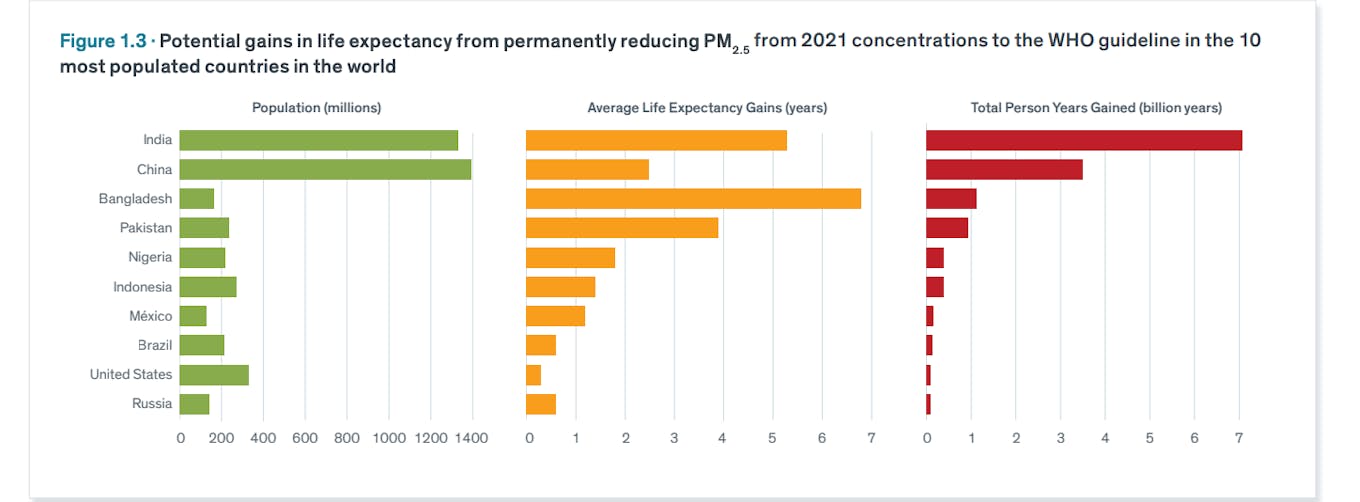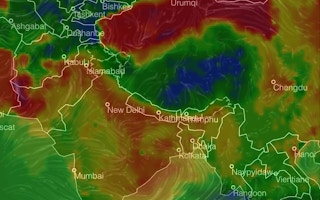Skyrocketing energy demand and fossil fuel use in South Asia over the past two decades have contributed to rising particulate emissions in the region. Bangladesh, India, Nepal, and Pakistan – where 22.9 per cent of the global population lives – are now the top four most polluted countries in the world and bear the greatest health burden for dirty air, latest data finds.
To continue reading, subscribe to Eco‑Business.
There's something for everyone. We offer a range of subscription plans.
- Access our stories and receive our Insights Weekly newsletter with the free EB Member plan.
- Unlock unlimited access to our content and archive with EB Circle.
- Publish your content with EB Premium.
The benchmark study, an annual report known as the Air Quality Life Index (AQLI), released in August by the Energy Policy Institute at the University of Chicago (Epic) revealed that residents in the four South Asian countries are expected to lose about five years of life expectancy on average if levels of pollution persist.
Since 2013, about 59 per cent of the world’s increase in pollution has come from India alone, said the study.
“Fortunately, more and more people in these countries are recognising the severity of the problem, and governments are beginning to respond.”
The report particularly cited how the government of India declared a “war on pollution” in 2019, launching a national clean air programme with a clear goal to reduce 2017 particulate pollution levels by 20 to 30 per cent by next year.
Last year, it renewed the target and said that the country aims to achieve a 40 per cent reduction in particulate pollution levels by 2026 in 131 non-attainment cities – or cities that have fallen short of national ambient air quality standards for over five years.
It remains to be seen, however, if India, with its resolute call to clean up air pollutants, can see sustained results like what China – another fossil fuel-reliant country – has achieved. The report calls attention to China’s success in its own “war on pollution” that has been ongoing for almost a decade. Latest data finds pollution in the country has declined each year since stricter policies were implemented.
China’s efforts ‘a remarkable success’
Across China, pollution levels in 2021 were down by 42.3 per cent compared to 2013 – the year before the country began its war on pollution – and the average Chinese citizen can expect to live 2.2 years longer because of the improvements in air quality, the report said. “In fact, the small decline in global pollution levels from 2013 to 2021 is entirely due to China’s progress,” it said.

Annual average PM2.5 concentrations in major regions in Mainland China, 1998-2021. China has seen significant improvements in its air quality since launching a “war on pollution”. In the graph, PRD stands for Pearl River Delta, YRD stands for Yangtze River Delta and BTH stands for Beijing-Tianjin-Hebei. Source: Air Quality Life Index 2023
In seven years, China has reduced almost as much air pollution as the United States did in three decades. Stringent public policies have led to this success, said the report. In China, coal is being replaced by a range of cleaner energy sources, such as natural gas, renewable energy, and nuclear power. Citizens are provided with real-time air quality data to raise awareness on air quality. Additionally, the country has shifted focus towards green planning urban spaces to make them more environment-friendly.
China has been “able to significantly reduce air pollution thanks to a persistent, public call for change followed by strong policies”, the report said, suggesting that political will and resources, both human and financial, can reinforce each other to produce better results for solving air pollution.
The report described China’s efforts to curb pollution a “remarkable success”, though it also said that the pollution in China is still six times what the World Health Organisation (WHO) recommended.
Because of its large population, China experiences the second highest health burden from pollution globally, behind India, in terms of total life years lost.
The report also cautioned that China has traditionally relied on a command-and-control approach to combat pollution, which has imposed substantial social and economic burdens.
A smog that won’t go away
India’s current war on pollution, on the other hand, puts a strong emphasis on expanding renewable energy, promoting electric vehicles and supplying LPG or liquefied petroleum gas cooking oil to millions of households. Its National Clean Air Programme (NCAP) has a target which looks at extending the life expectancy of residents. Observers have repeatedly also called upon the government to show political will, including to appoint a “clear functioning authority” with a specific mandate of improving air quality to work on the issue.
India’s cities, however, still suffer from hazardous air pollution. Late last year, Air Quality Index (AQI) readings in capital New Delhi oscillated between “very poor” and “severe”, as a thick layer of toxic smog hung over the city. It has spent the winter choked by such smog almost every year.
A report by the Urban Lab, Centre for Science and Environment Analysis on NCAP released in September last year highlighted how there is “barely any difference” in overall PM2.5 trends between the group of cities governed under the NCAP and those outside its ambit. Both these regions have mixed air quality depending on the climatic zone, which requires a measurable reduction in pollution to meet national air quality standards.

Increasing population is a contributing factor to air pollution and a lowered life expectancy in most South Asian countries. [Click to enlarge] Image: Air Quality Life Index 2023
According to the AQLI Index, several factors have worsened air quality in South Asia. Practices like crop burning, the operation of brick kilns, and rapid industrialisation contribute to air pollution. India’s status as a developing economy, coupled with its growing population, adds to the issue.
Additionally, the surge in vehicle usage in South Asian countries like India, Pakistan, and Bangladesh, has tripled the pollution load. The reliance on fossil fuels for electricity generation further escalates the issue, with their use growing year-on-year.
Across South Asia, the most polluted country is Bangladesh. Despite a 2.1 percent dip in particulate pollution compared to 2020 levels, pollution in Bangladesh has hovered around 14 to 15 times the WHO guideline for the past decade.
The report highlights efforts by other nations, other than India, in curbing air pollution. In Nepal, efforts are underway with the Air Quality Management Action Plan for Kathmandu Valley, aimed at regulating emissions from factories and vehicles. Pakistan has been increasing the deployment of pollution monitors and implementing seasonal closures of industrial zones in heavily polluted regions, particularly during the high heat energy demand winter months.
In Bangladesh, air pollution monitoring has doubled in eight major cities, and brick kiln owners are being encouraged to adopt cleaner technologies. A law was passed in 2019 to prohibit brick kiln production near residential, commercial, environmental, and agricultural areas. Looking ahead, the government has plans for a ‘phase-out’ of traditional brick kilns in favour of cleaner concrete block production by 2025 to mitigate air quality issues.










